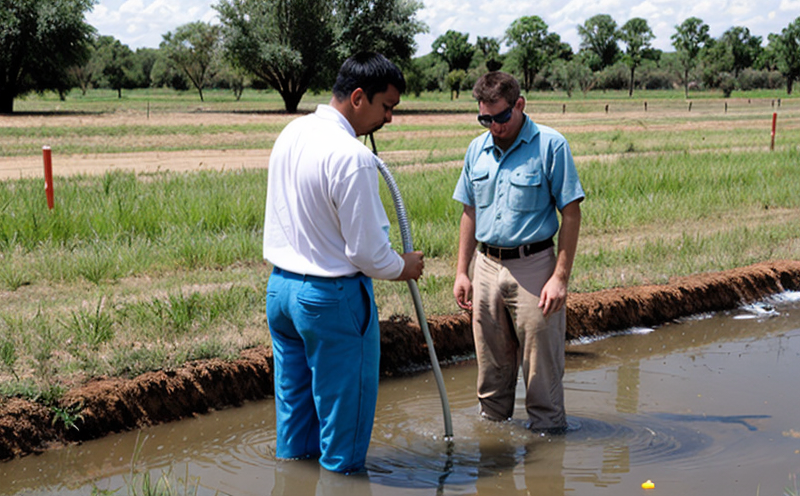OECD 203 Fish Acute Toxicity Test in Groundwater
The OECD (Organisation for Economic Co-operation and Development) Guideline 203 for Testing of Chemicals is a globally recognized method used to assess the acute toxicity of chemical substances on fish. This test is particularly important when evaluating potential contaminants that could affect groundwater quality, which serves as a critical resource for drinking water supplies, agriculture, and ecosystems.
The OECD 203 Fish Acute Toxicity Test in Groundwater is designed to determine whether a substance can cause lethal effects or impairments in fish within a short period. This test is crucial for environmental monitoring and compliance with regulatory standards such as ISO (International Organization for Standardization), ASTM (American Society for Testing and Materials), EN (European Norms), and IEC (International Electrotechnical Commission).
The OECD 203 protocol involves exposing fish to a series of dilutions of the test substance in groundwater. The test assesses the median lethal concentration (LC50) or median effect concentration (EC50) that causes lethality or sublethal effects, respectively, within four days. This information helps environmental scientists and engineers understand how chemicals may impact aquatic life and inform risk assessments.
During this process, it is essential to prepare the test specimens carefully. Fish used in these tests are typically adult rainbow trout (Oncorhynchus mykiss), as they are readily available and have a well-established response to chemical stressors. Specimen preparation includes acclimatizing the fish to the groundwater conditions for at least 24 hours before testing begins.
The OECD 203 Fish Acute Toxicity Test in Groundwater is conducted using specialized equipment, including aquaria with controlled water flow and temperature, aeration systems, and monitoring devices. The test setup ensures that all samples are exposed to the same conditions to maintain consistency and accuracy in results.
Once the test concludes, detailed reports are generated summarizing the findings, including the LC50 or EC50 values. These reports provide valuable data for regulatory compliance and decision-making processes related to environmental protection and resource management.
Scope and Methodology
| Test Purpose | To determine if a chemical substance poses an acute toxicity risk to fish in groundwater. |
|---|---|
| Test Substance | Any chemical compound or mixture intended for environmental release, including wastewater and agricultural runoff. |
| Test Specimen | Adult rainbow trout (Oncorhynchus mykiss). |
| Dilution Series | The test substance is prepared in a series of decreasing concentrations, ranging from 100% to 0.01%. |
| Test Duration | The fish are exposed for four days under controlled conditions. |
The OECD 203 protocol is designed to be robust and reproducible, ensuring accurate and reliable results. The test involves a series of steps, including preparing the test substance, acclimatizing the fish, setting up the aquaria, and conducting observations over the four-day exposure period.
Why Choose This Test
- Global Recognition: The OECD 203 protocol is widely accepted by regulatory bodies worldwide, ensuring that your test results are globally recognized and can be easily communicated across borders.
- Precision: The test provides precise data on the acute toxicity of chemicals in groundwater, which is essential for environmental protection and compliance with international standards.
- Risk Assessment: By identifying potential risks early, this test supports informed decision-making regarding chemical usage and disposal practices.
- Standardization: The use of standardized methods ensures consistency and comparability of results across different laboratories and regions.
- Ethical Consideration: This method uses a humane approach to testing, minimizing stress on the fish specimens while providing accurate data.
The OECD 203 Fish Acute Toxicity Test in Groundwater is an essential tool for ensuring environmental safety and compliance with regulatory requirements. It provides critical insights into the potential impacts of chemicals on aquatic life, supporting sustainable practices and informed decision-making processes.
Environmental and Sustainability Contributions
The OECD 203 Fish Acute Toxicity Test in Groundwater plays a pivotal role in environmental protection by providing accurate data on chemical toxicity. This information is vital for the development of effective mitigation strategies, ensuring that water quality standards are met or exceeded.
By identifying potential risks early, this test supports sustainable practices and helps prevent contamination of groundwater resources. This is particularly important given the increasing demand for clean water sources in an era of climate change and population growth.
The results of this test can inform best practices in chemical management and disposal, supporting a circular economy approach to resource use. By minimizing environmental impacts and promoting sustainable development, this test contributes significantly to global efforts towards sustainability.





